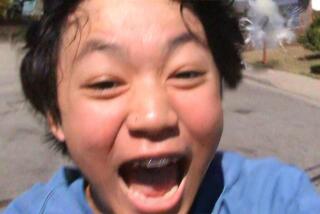‘Minding the Gap’ examines the troubled family lives of three young men, including the director’s
- Share via
What’s fascinating about “Minding the Gap,” the debut nonfiction feature from Chicago’s Bing Liu, is how much its story of young Midwestern skateboarders’ difficult maturation into manhood also documents Liu’s parallel growth as a filmmaker.
Begun as a much broader, issue-driven project in Liu’s early 20s, “Gap” evolved and deepened over several years as the fledgling director sharpened his storytelling gifts and found the nerve to turn the camera on himself and the same troubled family life he shared with his subjects. The film, which won a special jury award for breakthrough filmmaking at the 2018 Sundance Film Festival has now been nominated for an Academy Award.
“I didn’t set out to be in the film,” said Liu, 30, whose work is streaming on Hulu. He spends much of the time focused on Zack Mulligan, a party boy who unexpectedly becomes a father in a tumultuous relationship with his girlfriend, Nina, and Keire Johnson, a younger African American kid trying to find his way in a mostly white scene while in mourning for the death of an abusive father.
FULL COVERAGE: Get the latest on awards season from The Envelope »
Liu, likewise, suffered at the hands of a violent stepfather who imperiled his mother’s life. The details emerge well into the film, as Liu interviews her and reflects on his own escape into skateboarding as a teenager in Rockford, Ill., the fading Rust Belt town where Zack and Keire also grew up.
The scenes are an emotional gut-punch, yet articulated with the keen sensitivity that guides the entire production. “The interview was the last major shoot we did,” said Liu, whose ongoing discoveries about his subjects’ lives urged him to “put skin in the game.” The instincts of editor Joshua Altman found the moments the filmmaker “couldn’t emotionally go there to see.”
Besides underscoring the filmmaker’s guiding empathy, the footage also helped to seal a bond with Zack, Keire and Nina. “When I finally showed the film to everybody,” he said, “they were surprised that I put so much of my family’s story in there too. It felt like we’re all in this together now.”
And even though the film’s story and elemental relationships spring from the juvenile daredevil stunts of urban skate culture, Liu was careful about pushing that aspect. “I think the goal is to get young people engaged in the issues of domestic violence and child abuse, so it’s a good Trojan horse.”
Liu, who supported himself and picked up shooting skills working as an assistant cameraman on Chicago location productions of everything from “Shameless” to “Chi-Raq,” learned even more when he began a 2014 fellowship with Chicago’s Kartemquin Films. The nonprofit production company then got behind his film, with Steve James – whose classic “Hoop Dreams” is a model precedent for what “Gap” pursues – as an executive producer.
“That’s when I saw their films for the first time and became convinced that the mode of storytelling they’re doing is something I wanted to try,” said Liu, who also came onboard James’ nonfiction Starz series “America to Me” as a cinematographer and segment director. “Character-driven, putting story first, issues sort of take a back seat and you trust that it will organically come out.”
A significant part of Liu’s approach is his inclusion in the film of his frequent check-ins with his subjects and his own internal debate about how much to show.
It’s a quality, noted Eric Hynes, curator of film at the Museum of the Moving Image in Queens, N.Y., shared by some of the year’s most artful documentaries, including fellow nominee “Hale County This Morning, This Evening” and “Bisbee ’17.”
“Minding the Gap,” said Hynes, is “constantly asking questions of itself and of the people in the film as well as the ideas that get brought up. There’s no sense that this film knew what it wanted to be from Day One and you’re seeing an execution of that idea. Instead, you’re seeing something that’s alive. That film is completely alive from moment one to the end.”
More to Read
Sign up for The Envelope
Get exclusive awards season news, in-depth interviews and columnist Glenn Whipp’s must-read analysis straight to your inbox.
You may occasionally receive promotional content from the Los Angeles Times.






